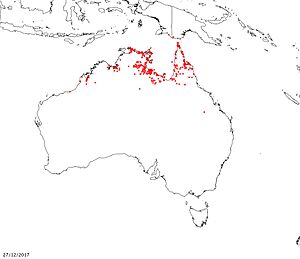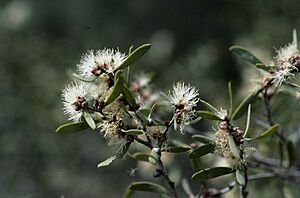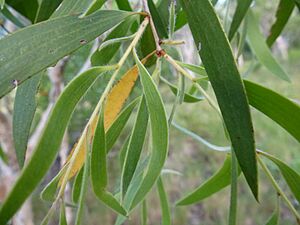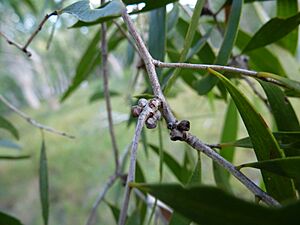Coastal paperbark facts for kids
Quick facts for kids Coastal paperbark |
|
|---|---|
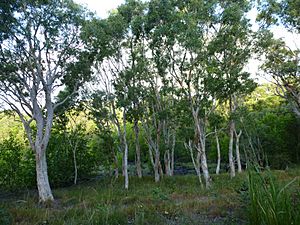 |
|
| Melaleuca acacioides near mangroves and Cooktown Cemetery, Queensland | |
| Scientific classification | |
| Genus: |
Melaleuca
|
| Species: |
acacioides
|
| Synonyms | |
|
|
The Melaleuca acacioides, also known as the coastal paperbark, is a cool plant. It belongs to the myrtle family, called Myrtaceae. This tree grows naturally in northern Northern Territory, Cape York Peninsula, and New Guinea. The Bardi people call it lunyamad.
It's a close cousin to Melaleuca alsophila and Melaleuca citrolens. You can tell them apart by how their flowers grow. This tree's flowers grow in groups of three. It's usually a small to medium-sized tree. Sometimes it has many trunks if it grows in open spaces. You'll often find it in salty soils that get flooded regularly, especially near mangrove trees.
Contents
What it Looks Like
The coastal paperbark is a tree that can grow up to 10 meters (about 33 feet) tall. It usually has white or grey bark that feels like paper. When the new parts of the plant grow, they are covered in soft, long hairs.
Its leaves grow one after another along the stems. They are about 23-70 millimeters (1-3 inches) long. They are also about 6-14 millimeters (0.2-0.5 inches) wide. When the leaves are fully grown, they are smooth and hairless. They are shaped like a narrow oval. Sometimes they have a tiny point at the end. You can see many small oil glands on the leaves.
The flowers are white to cream colored. They grow in spikes, which are like long clusters. These spikes can be at the very tips of the branches. They can also be in the spots where leaves join the stem. Each spike has 2 to 10 groups of flowers, with three flowers in each group.
Inside each flower, there are five bundles of stamens. Stamens are the parts that make pollen. Each bundle has 6 or 7 stamens. These flowers usually appear in winter and spring. After the flowers, you'll see woody seed pods. These pods are called capsules. They are about 1.6-2.3 millimeters (0.06-0.09 inches) long. They grow in clusters along the stem.
Naming the Tree
The Melaleuca acacioides was first officially described in 1862. This was done by a scientist named Ferdinand von Mueller. He wrote about it in his book Fragmenta Phytographiae Australiae.
The second part of its scientific name, acacioides, tells us something interesting. It means the leaves look similar to some types of Acacia trees. The ending -oides is a Latin word part. It means "resembling" or "looking like."
In 1986, another scientist, Bryan Barlow, studied the Melaleuca group again. He divided Melaleuca acacioides into different groups. One new species was named Melaleuca citrolens. He also named two subspecies:
- Melaleuca acacioides F.Muell. subsp. acacioides
- Melaleuca acacioides (A.Cunn.ex Benth.) Barlow subsp. alsophila.
Where it Grows
You can find the Melaleuca acacioides tree in a wide area. It grows from western Arnhem Land in the Northern Territory all the way to Cape York Peninsula. It also grows in New Guinea.
This tree likes to grow in slightly salty soils. These are often found on the land side of mangrove forests. It also grows near plants called samphire. These areas often get flooded by salty water.
How People Use It
Traditional Uses
Aboriginal people have used the leaves of Melaleuca acacioides for a long time. They would use them to add flavor to their cooking. They also used leaves from other similar trees, like M. argentea and M. leucadendra.
Another important food source was "bee bread" and honey. These came from native bee hives. These hives were common in swamp forests where Melaleuca acacioides trees grew.
Essential Oils
Scientists have studied the leaves of this tree. They found that the leaves contain special oils called essential oils. A big part of these oils are compounds called Selinenes. These are also found in celery seed oil. Essential oils are used in many products, like perfumes and medicines.
Other Uses
The wood from Melaleuca acacioides is strong and dark. People can use the tree trunks as small poles. The wood also makes good fuel for fires.
This tree can also be helpful in tough coastal areas. It can act as a natural windbreak. This means it helps protect other plants or buildings from strong winds.


